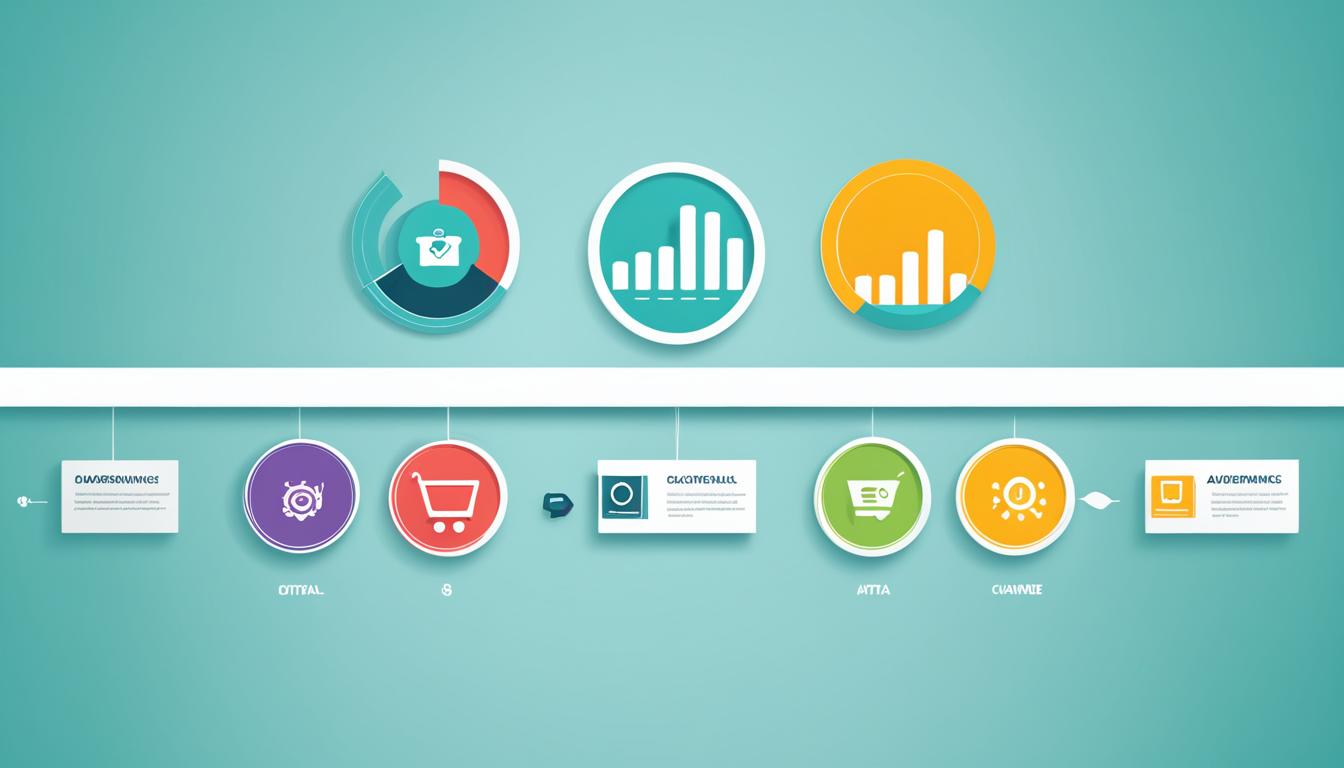Apple, a global tech giant, has established itself as a leader in the industry through a carefully crafted branding strategy. Apple’s success can be attributed to its innovative products, strategic marketing efforts, and focus on delivering a premium user experience.
One of the key elements of Apple’s branding strategy is its consistent emphasis on innovation. By launching groundbreaking products that capture consumers’ attention, Apple has been able to consistently increase its revenue and market share. This approach not only allows Apple to stay ahead of the competition but also reinforces its image as a technology innovator.
Additionally, Apple strategically prices its products to appeal to a wide range of customers, allowing it to penetrate various market segments. This pricing strategy, combined with its innovative product offerings, has contributed to Apple’s success in attracting tech enthusiasts, early adopters, creative professionals, students, educators, affluent consumers, and health and fitness enthusiasts.
Apple invests heavily in marketing and advertising efforts to increase sales and gain a larger market share. The company utilizes traditional advertising channels such as television and implements digital marketing strategies to effectively reach its target audience. The majority of Apple’s marketing campaigns focus on compelling storytelling, minimal design, and high-quality images, creating an emotional connection with the audience.
Furthermore, Apple’s branding approach is rooted in simplicity, elegance, and functionality. Its minimalist design philosophy, combined with a seamless user experience across all devices, has become part of the company’s DNA. Apple excels in creating an integrated ecosystem where devices work seamlessly together, extending this approach to its retail stores to provide the best possible customer experience.
Apple’s target audience primarily falls within the age group of 20-45 and includes professionals in fields such as music, video, photography, design, working professionals, managers, and executive-level workers. The company emphasizes providing a user interface that is simple to use and learn, catering to middle to upper-class demographics. Additionally, Apple products like iPads and MacBooks are preferred by students, educational institutions, and teaching professionals.
In conclusion, Apple’s branding strategy is characterized by innovation, minimalist design, premium user experience, and effective storytelling. By focusing on these key aspects, Apple has managed to establish a strong brand identity, stand out from competitors, and maintain a loyal customer base.
Key Takeaways:
- Apple’s success is attributed to its consistent emphasis on innovation and delivering products that capture consumers’ attention.
- Strategic pricing allows Apple to appeal to a wide range of customers and penetrate various market segments.
- Apple invests heavily in marketing and advertising to increase sales and reach its target audience through traditional and digital channels.
- Apple’s branding approach is rooted in simplicity, elegance, and functionality, contributing to a seamless user experience across all devices.
- Apple’s target audience primarily consists of professionals, students, and educators, with a focus on simplicity and minimalistic design.
Consistent Marketing Excellence
Apple has been recognized as a leader in marketing excellence, consistently setting the benchmark for other companies in the industry. Its marketing strategies are built on a consistent approach that focuses on innovation, customer engagement, and loyalty.
One of the hallmarks of Apple’s marketing success is its unwavering commitment to innovation. With each product release, Apple introduces groundbreaking features and designs that capture the attention of consumers worldwide. This consistent approach to pushing boundaries and challenging the status quo sets Apple apart from its competitors and reinforces its position as an industry leader.
Apple’s marketing campaigns go beyond simply listing product features. Instead, they focus on storytelling and evoking emotions, creating a connection with the audience. By emphasizing the values of innovation, design excellence, and user-centricity, Apple creates a brand narrative that resonates deeply with consumers.
Through its marketing efforts, Apple actively cultivates a sense of community among its consumers. By nurturing this community, Apple fosters a deep connection and loyalty towards the brand. This loyalty translates into long-term customer relationships that contribute to Apple’s continued success.
To maintain its market position and customer loyalty, Apple ensures remarkable consistency across all its products and services. This consistency creates a seamless user experience that keeps customers coming back. Apple’s commitment to user experience goes beyond its products and extends to its retail stores, which boast the highest retail sales per square foot among U.S. retailers.
Apple’s marketing success extends to its presence on major social media platforms like Facebook, Instagram, Twitter, and YouTube. Through carefully crafted posts and captivating visuals, Apple showcases its commitment to design, innovation, and user experience. By engaging with followers and responding to their queries and feedback, Apple fosters a sense of community and exclusivity.
Modern marketers can learn valuable lessons from Apple’s marketing strategies. By prioritizing innovation, consistency, and storytelling, marketers can craft compelling brand narratives and experiences that resonate with their own audience.
Minimalist Design Philosophy
Apple’s design philosophy is deeply rooted in minimalism, emphasizing simplicity, elegance, and functionality. This approach has been instrumental in shaping the success and popularity of their flagship product, the iPhone, as well as their other devices.
The minimalistic design of Apple products, especially the iPhone, focuses on simplifying human perception to optimize energy consumption and enhance the user experience. The use of basic shapes like circles, squares, and triangles in various design elements adds to the overall aesthetic appeal.
Symmetry is another key aspect of Apple’s design philosophy, as it enhances balance and stability in their products, appealing to a wider audience. By grouping and structuring design elements, Apple reduces cognitive load and streamlines information processing for users.
Apple’s implementation of minimalism in the design of the iPhone is evident in the body of the device, which is predominantly composed of straight lines and circles. Even the buttons, cameras, and ports adhere to the principle of using basic shapes in design.
The focus on a user-centric approach drives Apple’s development of intuitive interfaces and seamless interactions. They strive to create products that are not only visually appealing but also simple in form yet sophisticated in function.
Apple’s design process involves the integration of software and hardware to ensure a cohesive and controlled user experience. This approach allows them to deliver products that consistently meet the high standards they have set for themselves.
Jony Ive, Apple’s former design leader, played a pivotal role in shaping the company’s design philosophy. He emphasized minimalism, user-centric design, integration of form and function, material innovation, attention to detail, and uncompromising quality. It was under his guidance that iconic products like the iMac, iPod, iPhone, iPad, and MacBook were created.
Apple’s design principles have had a profound impact on the tech industry and beyond, influencing a wide range of products and industries. However, critics have highlighted the challenge of finding the right balance between minimalism and functionality, as it can sometimes limit innovation.
Nevertheless, Apple’s design ethos, guided by minimalism, simplicity, and elegance, continues to set a benchmark in design thinking in the tech industry and beyond.
The Seamless User Experience
Apple’s commitment to excellence goes beyond product innovation and design. The company prioritizes creating a seamless user experience across its entire ecosystem, from integrated devices to the retail experience and customer service.
According to a Temkin Group study, companies that invest in customer experience can gain significant financial benefits. With its focus on seamless user experiences, Apple has undoubtedly reaped the rewards. By providing a frictionless experience, Apple cultivates customer loyalty and drives repeat purchases, resulting in a positive impact on its bottom line.
Apple’s retail stores play a crucial role in delivering this seamless experience. The well-trained and knowledgeable staff members are equipped to assist customers with their Apple devices and provide exceptional customer service. This dedication to customer care ensures that users can fully optimize their Apple products and have a satisfying experience throughout their ownership journey.
In addition to its retail stores, Apple’s online presence is equally impressive. With an online store accessible in over 40 countries, Apple caters to a global customer base. This accessibility allows customers to explore and purchase Apple products conveniently from the comfort of their homes. The user-friendly interface and efficient customer support contribute to a cohesive and enjoyable online shopping experience.
Apple’s integrated ecosystem seamlessly connects its range of devices, enabling users to seamlessly transition between different devices and access their content effortlessly. This interconnectedness forms the foundation of the Apple ecosystem, empowering users to experience a unified and intuitive interface across devices.
The Apple ecosystem also extends beyond its own devices through strategic partnerships and integrations. For instance, Apple Music is available on various platforms, including Android devices, ensuring that users can enjoy their favorite music seamlessly, regardless of the device they use.
Apple’s user-centric approach is further reflected in its commitment to customer service. The company strives to address user needs promptly and effectively, demonstrating its dedication to ensuring customer satisfaction. Apple’s customer service channels, including online support, AppleCare, and the Genius Bar in its retail stores, provide users with personalized assistance and swift resolutions to any issues they may encounter.
The seamless user experience delivered by Apple has contributed significantly to the company’s success. By integrating devices, providing exceptional retail experiences, and prioritizing customer service, Apple has established itself as a leader in the technology industry, delighting customers and fostering long-term brand loyalty.
Apple’s Marketing Approach
Apple’s success is not only attributed to its high-quality products but also its unique marketing strategy. With a commitment to delivering exceptional customer experiences, Apple has built a loyal customer base and established a reputation for excellence.
One of Apple’s key marketing strategies is its focus on user experience. Apple understands that a seamless and intuitive user interface is crucial for customer satisfaction and loyalty. By prioritizing simplicity and functionality in their product design, Apple ensures that users have a positive and enjoyable experience with their devices.
In addition to user experience, Apple invests heavily in marketing campaigns that create buzz and anticipation. Their innovative product launches are meticulously planned to generate consumer interest and drive sales. Apple’s marketing team knows how to captivate audiences and build excitement around new releases, contributing to the company’s continued success.
Collaborations with high-profile figures are another integral part of Apple’s marketing strategy. By partnering with influencers, celebrities, and artists, Apple expands its reach and connects with a wider audience. These collaborations not only promote Apple’s products but also align the brand with influential individuals, enhancing its reputation and appeal.
Furthermore, Apple’s marketing approach encompasses a commitment to sustainability. Apple’s use of recycled materials in its products and packaging aligns with its environmental goals, demonstrating its dedication to minimizing its impact on the planet. This sustainability-focused marketing strategy resonates with consumers who value companies that prioritize environmental responsibility.
Apple’s marketing efforts are backed up by its extensive investment in Research and Development (R&D). By allocating a significant portion of its budget to R&D, Apple ensures continuous innovation and maintains its position as a leader in the tech industry. This commitment to pushing boundaries and introducing groundbreaking products further solidifies Apple’s reputation as a brand that delivers premium offerings.
Apple’s Marketing Approach
| Marketing Approach | Impact |
|---|---|
| User Experience Focus | Enhanced customer satisfaction and loyalty |
| Innovative Product Launches | Generates consumer interest and drives sales |
| Collaborations with High-Profile Figures | Expands reach and enhances reputation |
| Sustainability Strategy | Resonates with environmentally conscious consumers |
| Investment in Research and Development | Drives continuous innovation |
Apple’s marketing approach, with a focus on user experience, innovative product launches, collaborations, sustainability, and R&D investment, has propelled the company to the forefront of the tech industry. By consistently delivering exceptional customer experiences and maintaining a reputation for excellence, Apple continues to thrive in a competitive market.
Product Differentiation and Scarcity
Apple’s commitment to product differentiation has been a key factor in establishing and maintaining its position as a premium brand in the competitive IT sector. By consistently delivering ground-breaking innovations, Apple sets itself apart from its competitors and captures the attention of tech enthusiasts and consumers worldwide.
One of the strategies Apple employs to build anticipation and desire for its products is through controlled release and scarcity. Limited product launches, such as the iPhone SE and iPhone XR, have effectively created a sense of exclusivity and heightened customer perceptions of scarcity. This scarcity drives up demand and excitement, leading to long queues outside Apple stores on launch days and a passionate fanbase willing to camp overnight for the latest iPhone release.
Apple’s marketing efforts have successfully shaped the company’s brand image as one of innovation, quality, and fashion. The brand’s distinctive logo, stylish product designs, and premium pricing all contribute to a perception of exclusivity. Apple customers not only value the functionality of the products they purchase but also the status and prestige that comes with owning an Apple device.
Furthermore, Apple’s customer experience initiatives play a crucial role in fostering customer loyalty and the willingness of customers to pay a premium for its products. Apple’s in-store environments are designed to be engaging and immersive, creating a seamless and enjoyable shopping experience. Additionally, services like Apple Music and iCloud provide customers with added value and further integrate them into the Apple ecosystem.
Apple’s marketing strategy also includes building an emotional connection with its customers. Initiatives like the “Think Different” ad campaign have resonated with consumers, celebrating individuality, creativity, and challenging the status quo. This emotional connection strengthens customer loyalty and drives continued support for Apple’s products.
| Key Factors | Effects |
|---|---|
| Product differentiation | Establishes Apple as a premium brand |
| Controlled release and scarcity | Increases anticipation and desire for Apple products |
| Distinctive logo and stylish design | Enhances brand exclusivity |
| Premium pricing | Contributes to the perception of luxury |
| Engaging in-store environments | Creates a seamless and enjoyable shopping experience |
| Additional services like Apple Music and iCloud | Provides added value to customers |
| Emotional connection through marketing campaigns | Builds customer loyalty |
In conclusion, Apple’s focus on product differentiation, exclusivity, controlled release strategies, and the creation of scarcity has contributed significantly to the brand’s success. By combining these elements, Apple creates a unique and engaging customer experience that sets it apart from its competitors and cultivates a loyal customer base.
Apple’s Marketing Objectives
As one of the most valuable brands globally, Apple has achieved remarkable success by setting clear marketing objectives and consistently delivering on them. Apple’s marketing objectives encompass a range of strategic goals aimed at enhancing customer loyalty, increasing sales and market share, differentiating their products, maximizing customer satisfaction, and strengthening their ecosystem.
Cultivating Customer Loyalty
Apple places a strong emphasis on customer loyalty, aiming to create long-term relationships with its customers. By prioritizing customer experience and providing exceptional service, Apple has developed a loyal customer base that continues to choose Apple products over competitors. This customer loyalty is a critical factor in driving Apple’s sales and market share growth.
Driving Sales and Market Share
With a diverse product mix that includes MacBook, iPad, iPhone, Apple TV, and Apple Watch, Apple’s marketing objectives aim to drive sales and increase its market share across various product categories. Apple’s relentless commitment to innovation and product excellence has consistently attracted customers and contributed to its strong market presence.
Product Differentiation
Apple’s marketing objectives also revolve around product differentiation to stand out in a highly competitive market. By constantly pushing boundaries and introducing cutting-edge technologies, Apple sets itself apart from competitors and creates unique value propositions for customers.
Maximizing Customer Satisfaction
Customer satisfaction is a top priority for Apple, and the company uses the Net Promoter Score (NPS) to measure and improve customer satisfaction levels. Apple’s marketing efforts are designed with a customer-centric approach to ensure that their products and services not only meet but exceed customer expectations.
Strengthening the Ecosystem
Apple recognizes the significance of its ecosystem in delivering a seamless user experience across its products and services. To strengthen the ecosystem, Apple’s marketing objectives focus on integrating and aligning different devices and software, creating a cohesive and interconnected user experience that enhances customer satisfaction and loyalty.
Overall, Apple’s marketing objectives reflect the company’s commitment to delivering outstanding products, fostering customer loyalty, and shaping the future of technology.
Apple’s Target Audience
When it comes to captivating a specific group of consumers, Apple has mastered the art of precision targeting. With a brand value expected to reach $947 billion in 2022 and total net sales of $365.82 billion in 2021, Apple knows exactly who they are catering to.
Apple’s target audience consists of a diverse range of individuals who share a common desire for quality, performance, and design. From tech enthusiasts and creative professionals to affluent consumers and health and fitness enthusiasts, Apple leaves no stone unturned in attracting loyal fans.
With approximately 66% of its customer base being female, Apple has successfully connected with a predominantly female demographic. However, Apple’s appeal extends far beyond gender, resonating strongly with millennials and Gen X. In fact, the brand’s popularity among younger demographics is a testament to its ability to stay relevant and capture the attention of the next generation of consumers.
To delve deeper into Apple’s target audience, let’s explore some key demographic and psychographic segments:
- Tech Enthusiasts: Apple’s commitment to innovation and cutting-edge technology makes it a go-to choice for tech enthusiasts who prioritize the latest features and functionality.
- Creative Professionals: With sleek and powerful devices, Apple caters to the needs of creative professionals, offering seamless integration with design and editing software.
- Affluent Consumers: Apple’s premium brand positioning appeals to high earners and those who value the prestige associated with owning Apple products.
- Health and Fitness Enthusiasts: With advanced health tracking features and a wide range of fitness apps, Apple products are increasingly popular among individuals who prioritize health and wellness.
- Loyal Apple Fans: Apple has fostered a dedicated following of passionate and loyal fans who eagerly await the latest product releases and updates.
| Segment | Characteristics |
|---|---|
| Age | 18-45 years old, with a particular focus on the 18-30 age group for certain products |
| Gender | 66% female, 34% male |
| Lifestyle | Urban dwellers, high earners, middle and upper classes |
| Occupation | Professionals, executives, managers, students |
| Personality Traits | Ambitious, determined individuals |
Apple’s successful market segmentation strategy ensures that their products cater to the unique needs and preferences of specific consumer groups. By targeting these diverse segments, Apple has been able to create a sense of exclusivity while simultaneously appealing to a wide range of individuals.
Whether you’re a tech enthusiast, creative professional, affluent consumer, health and fitness enthusiast, or a loyal Apple fan, Apple’s products and services are designed to deliver a superior user experience and meet the expectations of even the most discerning consumers.
Conclusion
Apple’s branding strategy is a shining example of marketing excellence in the technology industry. Through their commitment to innovation, design, and customer experience, Apple has established a strong brand image and maintained market leadership. Their customer-centric approach and premium pricing have not only contributed to revenue growth but also fostered customer loyalty and advocacy.
By studying Apple’s branding strategy, businesses can learn valuable lessons on how to develop a unique and differentiated product portfolio. Emphasizing minimalist design and form-function integration can create products that stand out in a crowded market. Additionally, building a seamless user experience and a unified ecosystem of goods and services can enhance customer satisfaction and drive brand loyalty.
Apple’s marketing initiatives, known for their ability to generate anticipation and excitement, highlight the importance of creating emotional connections with customers. By incorporating storytelling and compelling events, brands can engage their target audience and elevate their own market presence. Furthermore, adopting a customer-centric approach, where the focus is on selling experiences rather than just products, can create lasting impressions and foster strong brand recognition.







